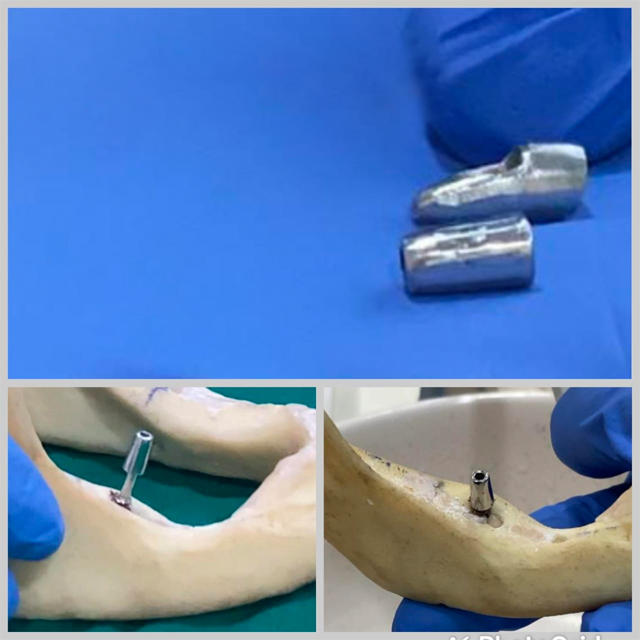As basal implantologists we should have some strategies where we get stuck up implant is stuck up or fractured we need certain modifications in the strategies to get better prosthetics. So all the dentists who have been struggling with slightly wrong angulation or if the implant head has broken this product is for you.
B21 Abutments By Basal Implants-This unique adaptor by trisa enterprise will help you if the implant head is stuck up. For example, you have placed a 3.5/17 implant and the implant is stuck at a very high level.
The implants is stuck supragingival or sometimes what happens is when you remove a temporary prosthesis and you see there is a lot of shrinkage of gingiva. So the simplest way is to cut off the implant at shaft level using a metal cutting bur and then you can take the b21 abutment roughen it and put a dual cure cement and cement it on the shaft.
- All BI are placed flapless. Expert operators can place them in all situations without the need for stents. Flapless placement with conventional implants is limited to cases where abundant bone volume is present for implant placement. The use of surgical stent is mandatory for flapless placement of conventional implants. Fabrication of stents for conventional implants need dual scans(more radiation) and further investment of time, money and effort.
- With the use of smooth surface basal implants the problem of periimplantitis simply does not exist. Peri-implantitis is an issue restricted to rough surface implants.
- The techniques in basal implants require 10-12 implants in the upper arch and 8-10 implants in a lower arch. Even for single posterior tooth replacements, 2-3 implants are placed. This leads to ideal force distribution under immediate loading situations. Placement of implants in posterior regions of maxilla and mandible during full arch replacements avoid cantilevering of prosthesis. The author finds this a better solution over techniques like ALLON 4 (practised by conventional implantologist) which has a lesser number of implants for load distribution. The placement of just four implants in anterior zone leads to the cantilevered design of the prosthesis.
- The unique one-piece mono block design of basal implants avoids problems associated with screw loosening which is very common with conventional implants.
- Working on resorbed ridges is less challenging with basal implants. The techniques allow flapless immediate loading even in the most resorbed jaws without need of bone grafting surgeries.
- One single compact surgical kit is enough for all basal implant surgeries as opposed to conventional implants, which need multiple kits for various procedures (e.g. kit for implant placements, kit for sinus lift, kit for ridge split etc.)
- By basal implants – These dental implants give people the strength and stability needed to eat all the foods they enjoy without having to struggle to chew by replacing missing tooth roots. Additionally, these kinds promote face characteristics by stimulating and maintaining jawbone, which helps stop bone loss.various kinds of dental implants
Your prosthodontists can select from a variety of coating, connection, and size options for each type of dental implant. Implant placement techniques come in a variety of forms, but they generally fall into one of two groups.B21 Abutments By Basal Implants – -Endosteal (Endosseous) Implants: dental implants are the most widely utilised kind. They are occasionally used in place of removable dentures or bridges. Endosteal implants come in screw or cylinder (threaded), smooth or bladed varieties. Your prosthodontist can help you choose the dental implant type that will work best for you, but endosteal implants are currently the most widely utilised option since they are secure, reliable, and widely accepted.Treatment: With endosteal implants, a titanium screw that serves as an artificial root is initially drilled into the jawbone. You must wait for the soft tissue and bone around the root to recover before you can complete the therapy. This is frequently a few months.
Endosteal implants are renowned for producing the most stable, realistic-looking results.
In order to begin an endosteal implant, the jawbone must be healthy and dense enough to support the implant. You might not have enough bone needed for an endosteal implant if you naturally have a narrow jawbone ridge or if one is short, constricted, and worn down as a result of trauma or disease. Considering this, a subperiosteal implant
Only logged in customers who have purchased this product may leave a review.
Need Help? Contact Us Leave Feedback
Category: Implantology
Tags: alpha bio dental implant + abutment, angled abutment, angled abutment dental implant, angled dental abutment, angled dental implants, angulated abutment, B21 abutment, B21 abutment by basal implants, B21 abutments, biohorizons dental implant abutment, broken dental implant abutment screw, consideration of implant abutment and crown contour, dental abutments types, dental code for implant bridge abutment, dental implant abutment, dental implant abutment and crown, dental implant abutment and crown cost, dental implant abutment and crown fell out, dental implant abutment bleeding, dental implant abutment breakage, dental implant abutment broke, dental implant abutment broken, dental implant abutment failure, dental implant abutment fell out, dental implant abutment fell out what to do, dental implant abutment procedure, dental implant abutment procedure time, dental implant abutment showing, dental implant angled abutment, dental implant with abutment and ceramic crown, dental implants abutment and crown average cost, dental implants angled abutments, different types of dental abutments, HEALwaalaHealium, tooth implant and abutment, types of abutment in dentistry, what is a dental abutment




Reviews
There are no reviews yet.